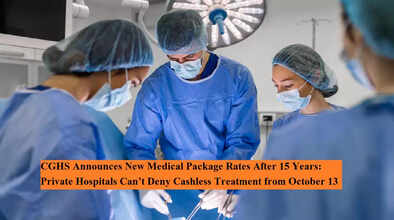CGHS Announces New Medical Package Rates After 15 Years: Private Hospitals Can’t Deny Cashless Treatment from October 13

The Central Government has made a major announcement for over one crore central government employees and pensioners. For the first time in 15 years, the Central Government Health Scheme (CGHS) has undergone a major revision, introducing nearly 2,000 new medical package rates. The updated rates will come into effect from October 13, 2025, making cashless treatment in private hospitals easier and more accessible for CGHS beneficiaries.
Why the Revision Was Needed
For years, several private hospitals under CGHS had been reluctant to provide cashless treatment, citing outdated package rates and delayed payments as the main reasons. As a result, many central employees and pensioners were forced to pay medical expenses from their own pockets and wait for months to get refunds.
In August 2025, the Central Government Employees’ Union (GENC) urged the government to revise the old rates and improve the system. In several instances, even emergency treatments were denied, highlighting the urgent need for reform.
Responding to these concerns, the Ministry of Health introduced a comprehensive revision aimed at rebuilding trust between hospitals and CGHS beneficiaries.
Key Features of the New CGHS Package Rates
The revised structure introduces city-wise and hospital category-based pricing, ensuring greater transparency and fairness. Here’s how the new system works:
-
Rates will vary by city tier and hospital accreditation.
-
Tier-II cities: 19% lower than the base rate.
-
Tier-III cities: 20% lower than the base rate.
-
NABH-accredited hospitals: Base rate applicable.
-
Non-NABH hospitals: 15% lower than the base rate.
-
Super-speciality hospitals (200+ beds): 15% higher than the base rate.
This model is designed to ensure regional affordability while still encouraging quality healthcare standards through accreditation incentives.
How Employees and Hospitals Benefit
The updated CGHS system brings relief to both patients and healthcare providers:
-
Cashless treatment will be easier and faster, reducing the need for out-of-pocket expenses.
-
Hospitals are more likely to accept CGHS patients due to realistic package pricing.
-
Refunds will be processed more efficiently, minimizing delays.
-
Beneficiaries will have renewed confidence in availing treatment at empaneled private hospitals.
This move not only improves access to healthcare but also streamlines the administrative process for both sides.
Additional Policy Changes Announced
On September 16, 2025, the Ministry of Health updated the CS (MA) Rules, 1944, expanding eligibility under CGHS.
Under the new rules:
-
Transgender children and siblings of central government employees can now benefit from CGHS coverage, provided they are financially dependent and certified under the Transgender Persons (Protection of Rights) Act, 2019.
Recent Improvements in CGHS Services
In the past year, the government has focused on digitization and accessibility within CGHS. Key upgrades include:
-
Strengthened CGHS online portal and mobile app.
-
Cashless treatment available at a wider network of hospitals.
-
Inclusion of new private hospitals in the CGHS panel.
-
Introduction of an online referral approval system for quicker clearances.
-
Real-time medicine tracking for transparency.
-
Dedicated helpdesks for senior citizens to address their concerns more efficiently.
Eligibility: Who Can Avail CGHS Benefits?
The CGHS is available to:
-
All central government employees and their families, excluding those from Railways and the Delhi Administration.
-
Central government pensioners, except for those from the Railways and Armed Forces.
Eligibility depends on residing in a city covered under CGHS, which currently operates in 80 cities across India.
How to Apply for a CGHS Card
-
For employees: Submit the prescribed form along with family photographs through your department.
-
For pensioners: Apply at the Additional Director’s office of your city or download the form from cghs.gov.in.
-
If the PPO (Pension Payment Order) is not ready, a provisional CGHS card can be issued based on the Last Pay Certificate (LPC).
-
How to Check the New Rates and Procedure Codes
Beneficiaries can visit the official CGHS website and navigate to the “Circulars/Notifications” section. There, you can download the official PDF document listing all updated package rates and procedure codes.
For example, in 2024, the rate for Laparoscopic Cholecystectomy was ₹33,000 in NABH-accredited hospitals and ₹28,050 in non-NABH hospitals. With the new revision, such disparities will now follow a clear, structured formula.
Final Takeaway
The government’s decision to overhaul the CGHS rates after 15 years marks a historic step toward modernizing India’s public healthcare system for central employees and pensioners. With revised rates, wider coverage, and improved digital infrastructure, beneficiaries can now expect faster, fairer, and more transparent medical services — ensuring that no private hospital can deny cashless treatment to CGHS cardholders from October 13, 2025.

